Since their impressive achievements of the last Euros, the Danish national side has achieved varying levels of success, qualifying for the 2022 Qatar World Cup.
However, they failed to register a win and finished bottom of their group.
However, more recently, in qualifying, Denmark topped its group ahead of fellow group C competitors Slovenia.
With seven wins, two losses, and a draw, it showed inconsistent success.
In this tactical analysis, we break down the key players and tactics that Denmark has used this season.
This scout report will also break down how they play within the three primary phases of the game (attacking, defensive, and transitions).
We will also look at the players who will likely make the trip to Germany and some who could significantly impact Denmark’s ability to succeed.
Predicted Starting XI
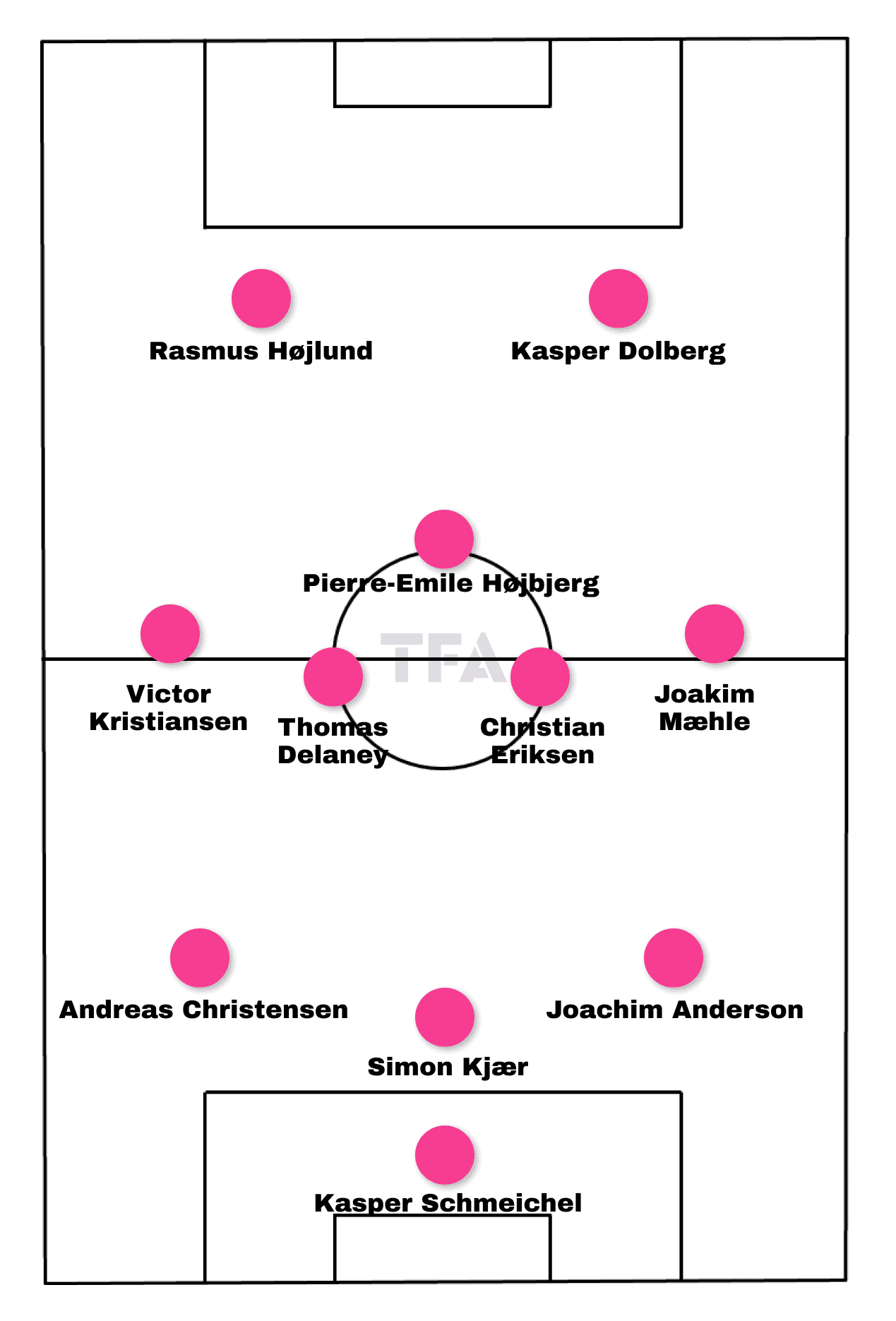
Kasper Hjulmand has used two formations throughout qualifying, switching between a 3-5-2 and a 4-3-3 shape.
We predict that he will go with the 3-5-2, as it seems to fit the profile of available players slightly more.
In goal, we have gone with the tried and tested Kasper Schmeichel with, at 37, this likely to be his last international competition.
In front of Schmeichel, we have gone with a back three of Simon Kjær, the captain, Andreas Christensen on the left and Crystal Palace’s Joachim Anderson on the right of the backline.
These centre-backs are going to be integral to how Denmark looks to play with the ball.
Then you have the two wing-backs, who will drop back into the backline defensively to help form a 5-3-2 shape while pushing forward in attack to help create a 3-2-5 shape.
We predict that it will be Joakim Mæhle on the right and Victor Kristiansen on the left.
Then comes the midfield, where Denmark has a plethora of options.
However, the most tried-and-tested combination we have chosen is Pierre-Emile Højbjerg as the primary deep pivot alongside Thomas Delaney as an additional pivot player.
Then you have Christian Eriksenfor playing more advanced, looking to find pockets of space to break down opposition shapes.
Then, for the front two, we first went with Rasmus Højlund of Manchester United.
Then came the partner for him; this was slightly more difficult.
We could have gone with Yussuf Poulsen or Kasper Dolberg.
In the end, we went with Dolberg as he was used slightly more in qualification; however, Poulsen and Højlund have played together a significant amount already as well.
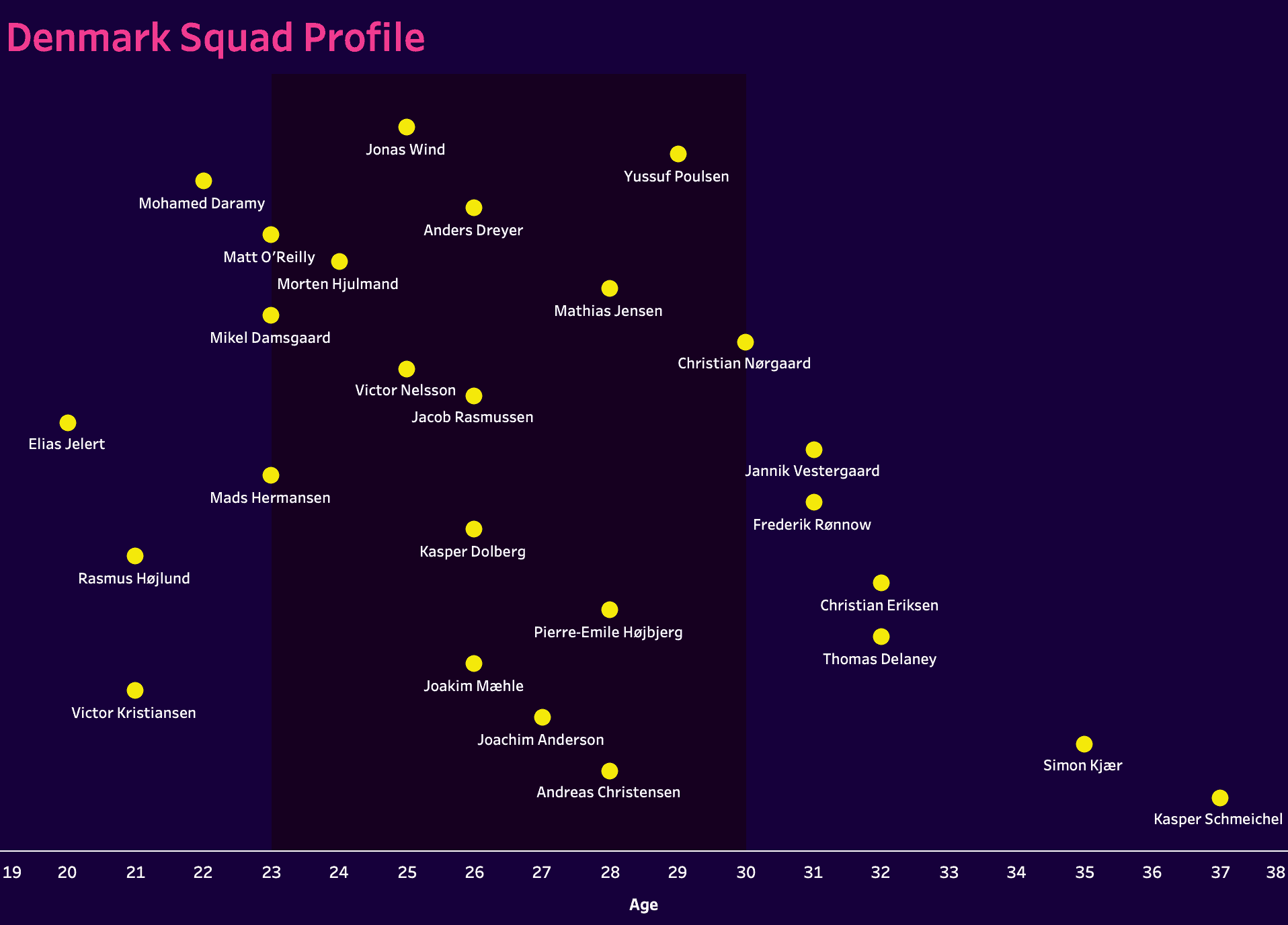
Denmark Attacking Phase
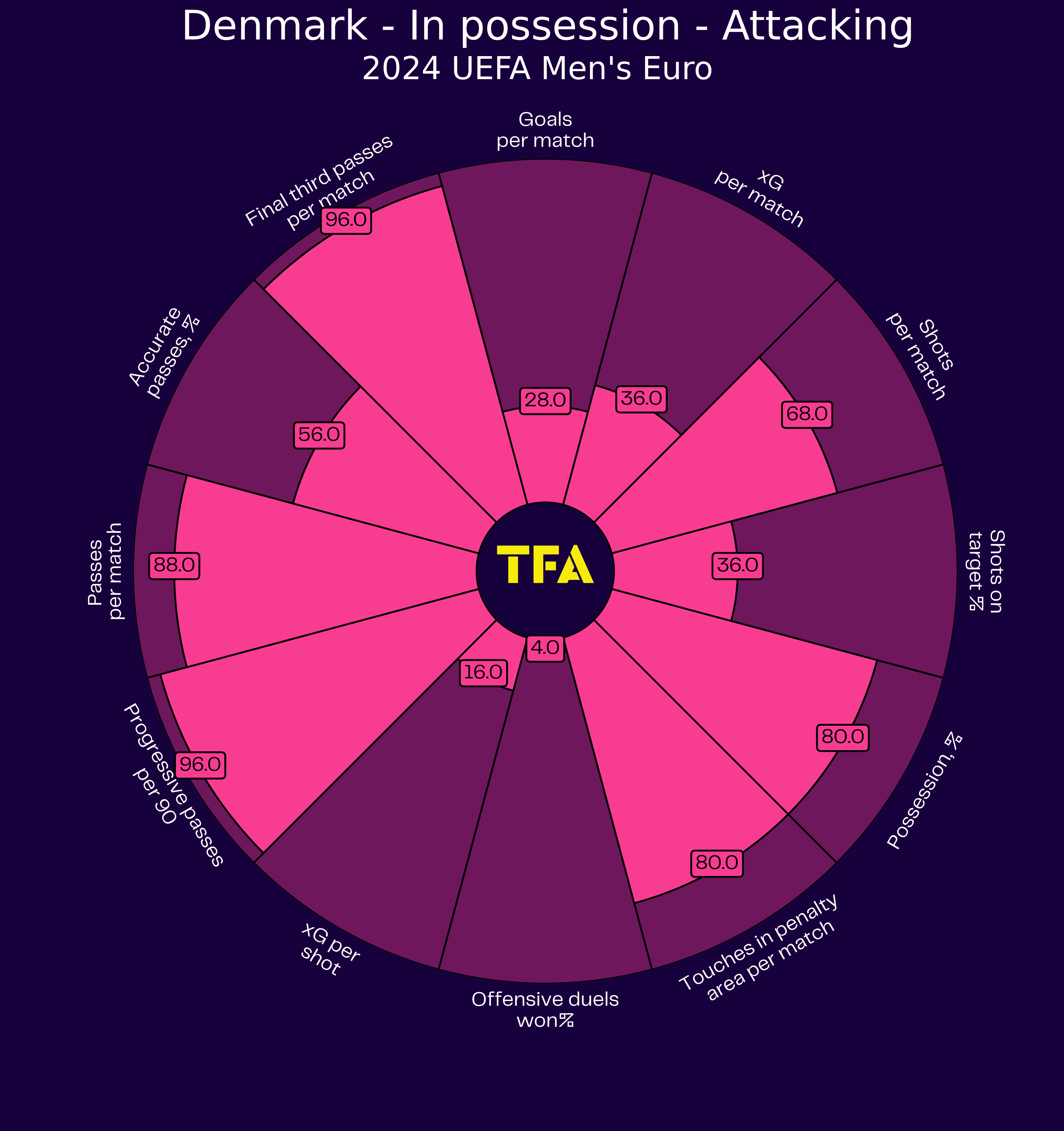
Denmark has demonstrated an intention to dominate the ball for long spells of the game, averaging 66.16% possession per game throughout the qualification phase.
It has lots of technically gifted players, particularly in the midfield, who are able to break down the opponent’s shape and progress the ball up the field.
Denmark averages 92.1 progressive passes per 90 minutes, which puts them in the 96th percentile amongst anybody competing at this year’s Euros.

The graphics from two recent games against Slovenia and Switzerland above show the spread of passes across the field.
Equally important to note is the number of passes that go through the middle of the field, which would indicate moments when Denmark looks to play forwards through shape.
Having looked at some of the underlying numbers that demonstrate Denmark’s proficiency in possession, let’s take a look at what they actually do in possession.
They typically play with a back three, which enables Denmark to move the ball from side to side efficiently if needed.
They then play with two midfield pivots, often Delaney and Højbjerg, trying to pick in the passes to progress attacks.
Then, what you have on the front line is typically a front four created from the two wide wing-backs and the two centre-forwards in the middle.
That leaves us with the attacking midfielder, often Christian Eriksen, who plays between the lines, looking to find pockets of space to support attacks.
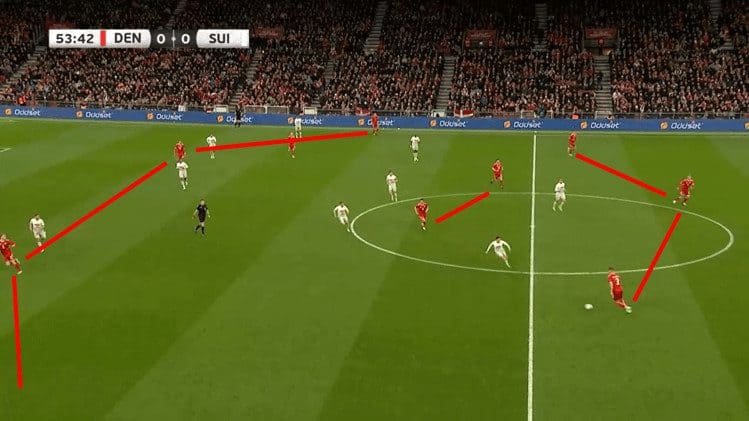
In this game against Switzerland, you can see how the Denmark back three spread wide across the field.
The two deeper midfielders, Delaney and Højbjerg, played as double pivots.
You have Mæhle on the right flank hugging the right touchline, and then, just out of the picture, you have Kristiansen on the left flank holding the width.
Centrally, you have Højlund, the left-centre forward, looking to make a run in behind and stretch the opposition.
Yussuf Poulsen, the right-centre forward, plays with his back to goal.
Then you have Christian Eriksen, the creative midfielder between the lines, finding pockets of space in the Switzerland shape.
Despite controlling large amounts of possession and field position, one area in which Denmark had inconsistent levels of success was in front of goal with goal chance creation.
The Denmark side averaging an xG of 1.76 per 90, which comes from an average of 14.2 shots per 90 and an average of 0.12 xG per shot.
However, despite this, let’s look at where Denmark’s chances have most commonly been created in the lead-up to the competition and some potential strengths to build on in the Euros.
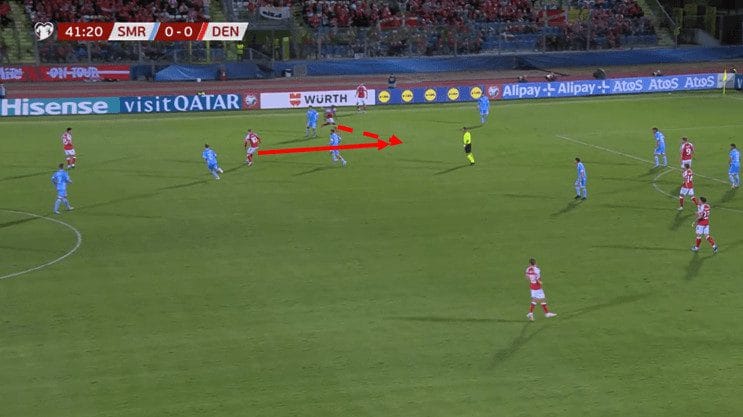
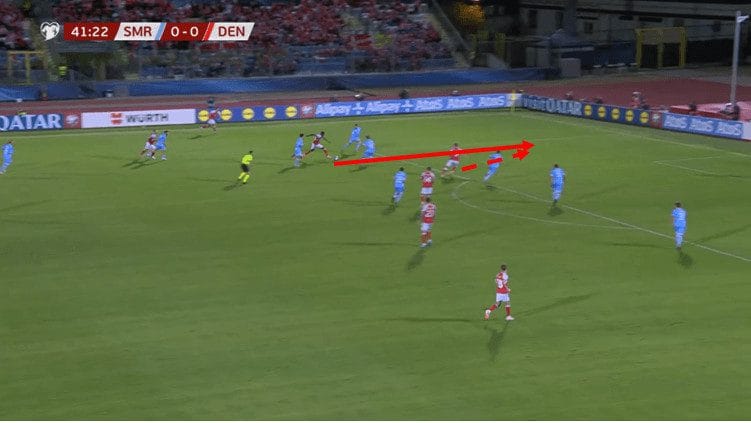
One of the most significant ways that Denmark can progress the ball is through its midfielders, who create goal-scoring opportunities with intelligent off-the-ball movements, such as this example where Eriksen plays a one-two with Daramy.
This smart movement breaks San Marino’s midfield line and draws the defenders towards Daramy.
The gap left behind is then exploited by Højlund, whose movement results in a shot and a goal.
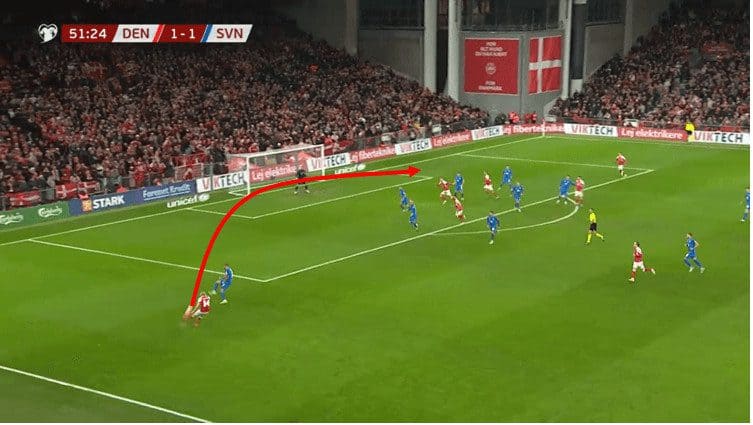
In this example, they can create an isolated one-on-one situation out wide, where Kristiansen can cross the ball towards the bodies in the box and create an opportunity for a teammate to attack the ball.
Denmark Defensive Phase
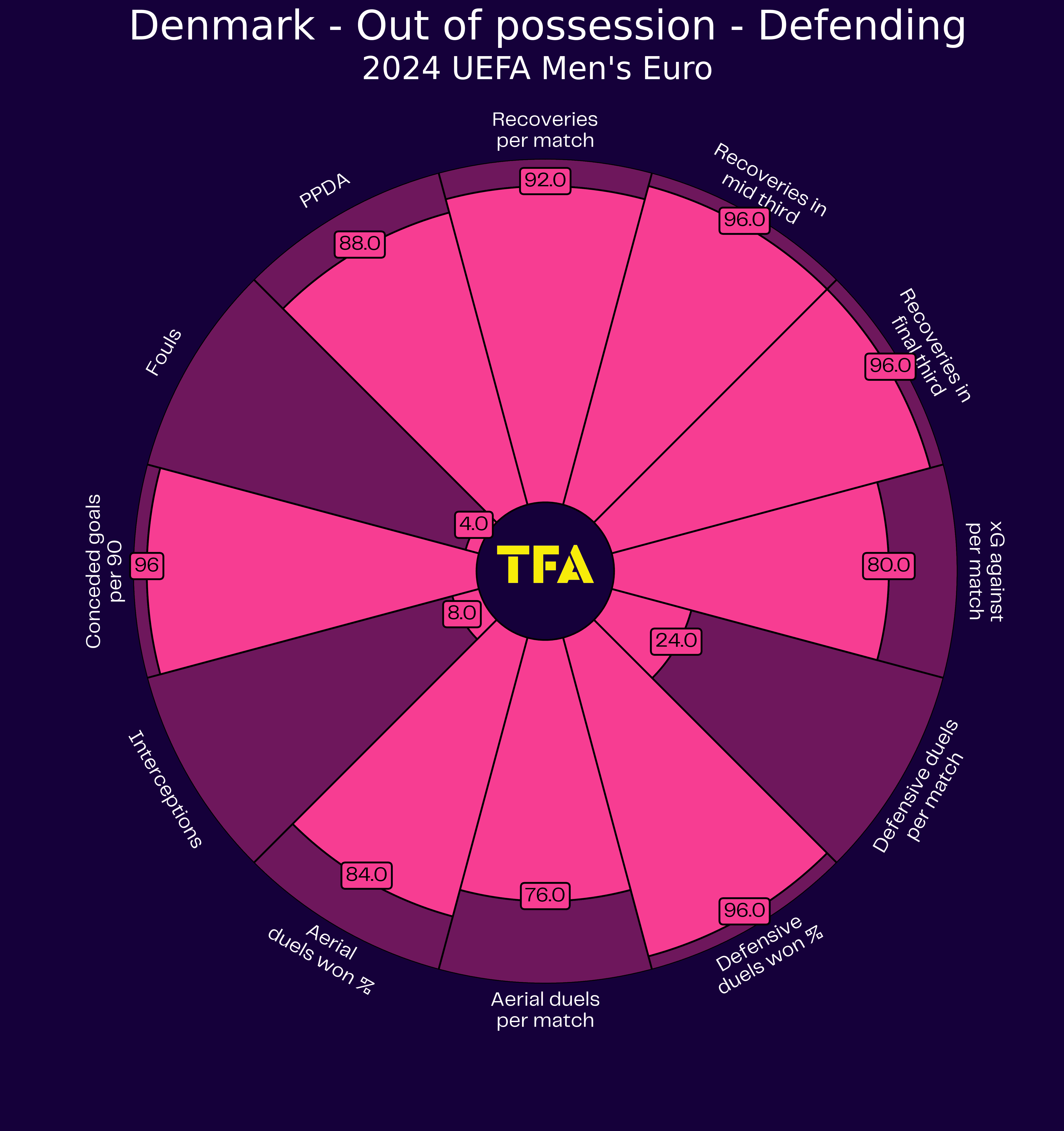
Having looked at the attacking phase, let’s see how Denmark plays during the defensive phase.
The first thing that jumps off the screen is their intention to press and regain the ball as quickly as possible.
This fits their model of trying to assert dominance of possession.
Denmark averaged a PPDA of 8.04 throughout qualification and they are in the 88th percentile amongst other teams in the competition.
Not only was Denmark’s press intense, but Denmark also looked to engage high up the field and averaged 20.6 ball recoveries in the final third of the field.
This was integral in them being able to control territory throughout possession.
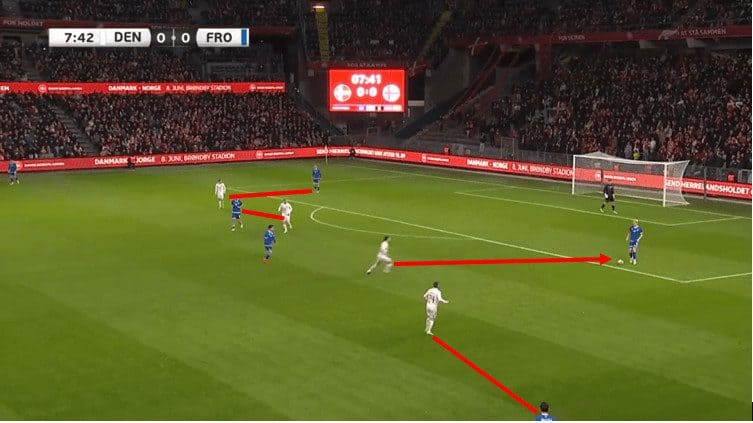
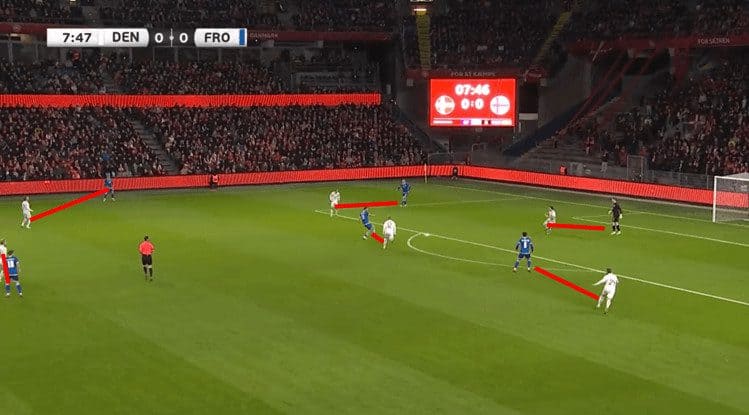
Here, you have Denmark executing their high press against the Faroe Islands.
With Hojbjerg initiating the press and leaving his man while still having the understanding to block the passing lane to the man he has just left.
This then forces the Faroe Islands to play backwards, forcing them onto the left side of the field, where Denmark is able to compress the side of the field and force the mistake of winning the ball back into the box.
Having looked at how they defend on the front foot, let’s look at how they defend on the back foot deeper in their own third.
Throughout qualification, they were able to limit their opponents to only 0.61xG per 90, which puts them in the 80th percentile amongst all teams in the Euros.
Denmark would sit back in a 5-4-1 shape.
You would have the wide centre-back, wing-back, and midfielder in wide areas, creating numerical strength.
Then, centrally, you would have the weak side wing-back tucking to leave three defenders in the box supported by two midfielders offering that extra support just in front.
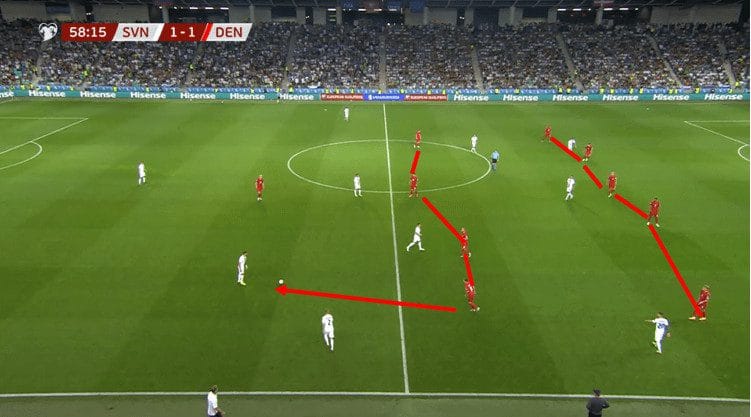
Here, you can clearly see the 5-4-1 shape of the Denmark side, with a high defensive line and Damsgaard, Eriksen, Højbjerg, and Olsen spread across the midfield line.
What is also interesting about this clip is that as Slovenia plays the ball backwards, this triggers Damsgaard to press and Højbjerg to follow, which in the end forces Slovenia into a long ball that Denmark’s centre-backs are able to get to.
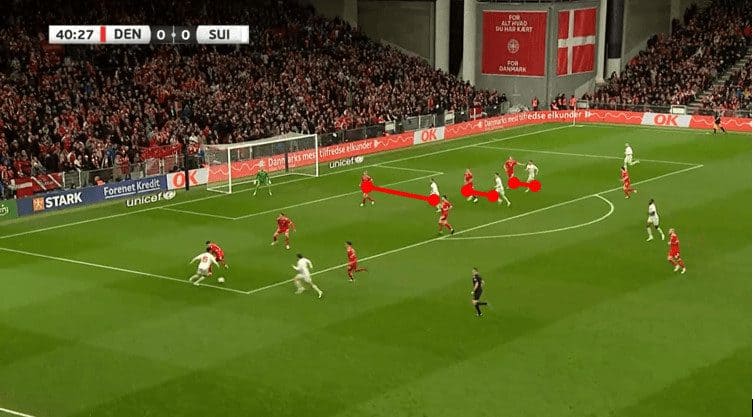
Here, you can see Denmark’s deep defensive shape.
Poulsen dropped deep to support Mæhle out wide, with Anderson supporting on the inside.
The other three defenders, Kjær, Vestergaard, and Kristiansen, are all tracking opponents in the box.
Midfielders Delaney and particularly Højbjerg are positioned around the edge of the box.
This all contributes to Denmark’s creation of a compact box, which gives little to no room for Switzerland to create space and forces them to win one-on-one to create a goal-scoring opportunity.
Denmark Transitions
They have demonstrated Denmark’s ability to dominate possession and territory.
Most teams have looked to set up to target them on the counterattack.
Therefore, their rest defence has been integral to their success.
Denmark’s best defence has been a 3-2 shape, with Højbjerg and Delaney sitting in front of the backline.
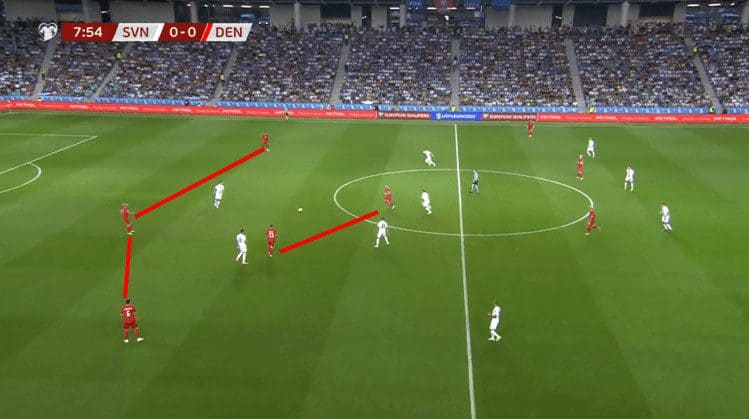
Here, you can see the 3-2 shape of the Denmark side, with the two wing-backs pushing forward to create a front five.
However, the wide centre-backs help cover for these advanced wing-backs.
So, when the ball is lost in the midfield, they are able to deal with the counterattack.
Although not generally a strength for Denmark, with the speed of somebody like Højlund behind the defence, they have demonstrated the ability to have some success on the counterattack.
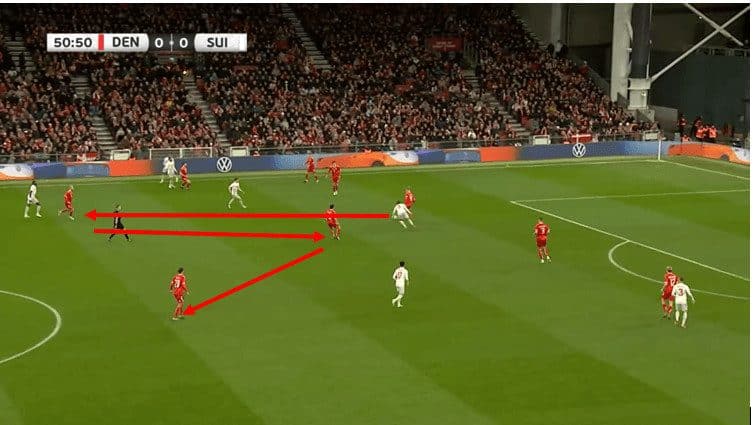
In this example, Kjær wins the ball back deep, and then instantly, Denmark is able to play short, sharp passes to progress the ball up the field with a quick ball to Eriksen, who drops it to Delaney, who passes it forward to Poulsen, who is in space and able to drive forward with the ball on the counterattack.
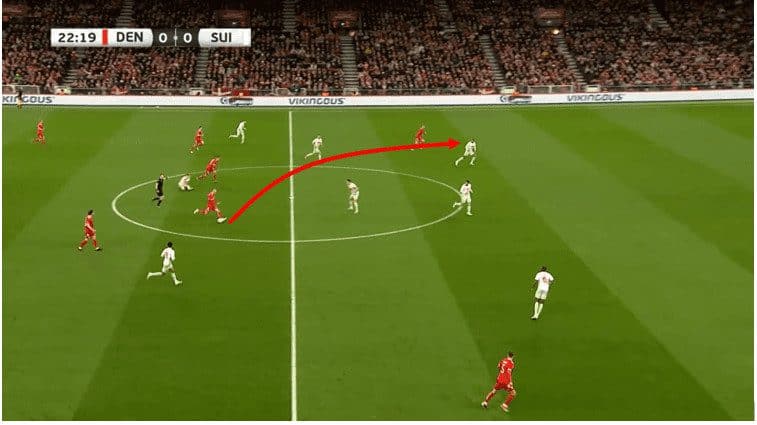
An alternative option they have is to attack with speed.
In this example against Switzerland, Denmark is on the counterattack with Eriksen on the ball in the midfield.
What you can clearly see is that Denmark’s two forward options, Mæhle and Højlund, are spread wide apart.
Højlund’s pace is then a valuable asset, either for him to run onto the ball or to drive forward on the ball, with Mæhle also a gifted ball carrier.
Denmark Forwards
Let’s take a more in-depth look at some of the forward options available to Denmark this summer.
Earlier, we spoke about Hjulmand’s ability to switch between a 4-3-3 and 3-5-2 formation.
We will look at options for both systems here.
With Yusuff Poulsen, you have a big, strong centre-forward who can hold up the play and be an outlet for the team to use with his back to the goal.
Jonas Wind offers a skill set similar to Poulsen’s; however, he is more able to link with teammates and will drop slightly deeper between the lines.
Again, Kasper Dolberg is similar to Wind in that he can drop into the midfield and help link the team together.
Then you have Rasmus Højlund, who has had a solid first season at Manchester United.
He offers this Denmark team a natural goalscorer who can take the top off the defence with runs beyond the backline, which adds a different dimension to the side that isn’t provided by the already mentioned options.
Then, there are two different players who are more natural wingers.
Anders Dreyer is a left-footed winger from Anderlecht who likes to drive, cut off the right wing, and take on opponents.
At the same time, Mohammed Daramy, who plies his trade for Reims in France, is a dynamic left winger who could offer a different proposition to opponents, particularly coming off the bench against tiring defences late in the game.
Denmark Midfielders
Now, let’s look at some of Denmark’s midfielders.
Denmark has an absolute plethora of options in the central midfield area, with a number of intelligent, technically proficient midfielders who can progress the ball through the thirds and break oppositions down.
We have already highlighted Pierre-Emile Højbjerg and Thomas Delaney as likely starters for the Danish side.
Both players are capable of being deep midfielders.
In addition to these two players, Denmark could call upon Brentford’s pairing of Christian Nørgaard or Mathias Jensen.
In addition to these players already competing in Europe’s top 5 divisions, they have Sporting Lisbon’s 24-year-old up-and-coming deep midfielder Morten Hjumland, who has impressed this season as Lisbon won the 2023/24 Primeira Liga.
Having examined Denmark’s deeper options, let’s examine perhaps the most important midfielder if Denmark succeeds: Christian Eriksen.
Having already noted Denmark’s struggles with converting good territory and possession into quality goalscoring opportunities, Eriksen will likely play a vital role in terms of goal creation.
Then we have Mikkel Damsgaard, who was one of Denmark’s breakthrough players in the last few Euros.
Although he was primarily a left winger, since then, he has become a regular central midfielder for Brentford in the Premier League and offers a different style of midfielder to those already mentioned, as he can be effective in supporting attacks in wide areas.
Finally, we have Matt O’Reilly, who has impressed for Celtic this season.
Although he generally plays as a right central midfielder, he has the flexibility to cover a number of positions out wide and in more advanced positions as well.
Denmark Defenders
Now, let’s take a look at the defenders Denmark could take to the Euros this summer.
To start off with, you would have to imagine Simon Kjær makes the squad as the nation’s captain.
Andreas Christensen’s quality and track record speak for themselves; having made 29 appearances for Barcelona this term, he should be a shoo-in for the squad.
Then the third centre-back we think will start is Joachim Anderson, who has been a vital part of the recent Crystal Palace revival under Oliver Glasner at the back end of the season.
In addition to being a capable centre-back, Anderson offers the versatility to play as a right-back as well if inclined to play in a back four instead.
We would also expect Denmark to bring Jannik Vestergaard on the plane to Germany as he brings Premier League experience and has had a successful season, winning the Championship with Leicester this term.
Then, let’s take a look at Denmark’s full-back options.
Joakim Mæhle has been a consistent performer for the national side over the past few years and would likely start as a right-sided wing-back, as he does for his club side Brentford.
Then, as a left-sided wing-back, we have Victor Kristiansen, who has been vital for Thiago Motta’s impressive Bologna side all season.
Then comes the difficult part: who else should be brought into the squad to achieve the right balance? Copenhagen’s young right-back Elias Jelert offers depth in a position that needs it, so we have included him.
Alternatively, Denmark could go with the more experienced Victor Kristiansen or Mads Roerslev.
Then comes another difficult decision to make between extra defensive options, with Benfica’s Alexander Bah, Galatasaray’s Victor Nelsson, Brentford’s Mathias Jorgensen and Brøndby’s Jacob Rasmussen all being strong defensive options for Denmark.
Denmark Key Player
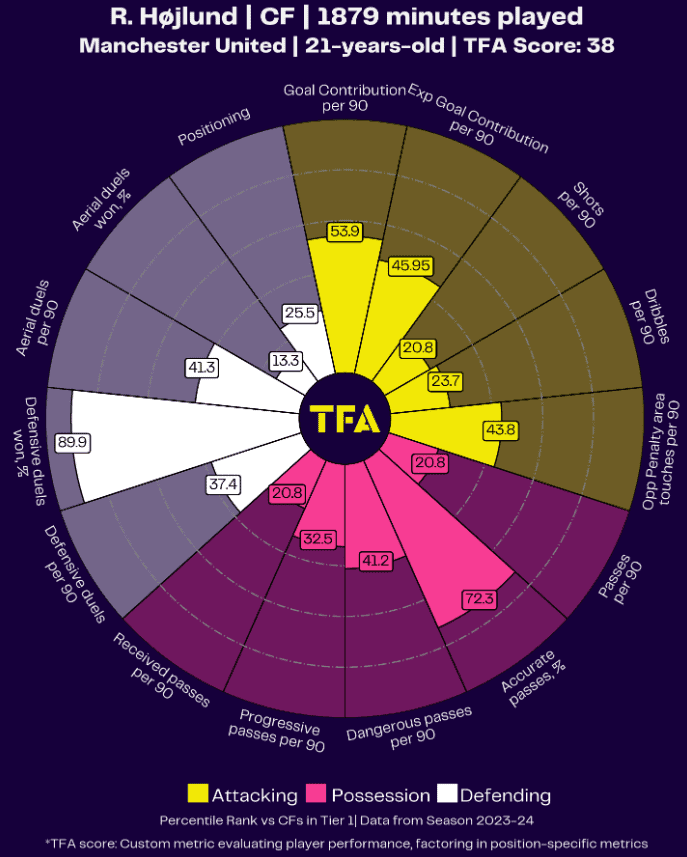
One of the major things that Denmark has missed in the past two international competitions is a goalscorer.
They only scored one goal at the World Cup in Qatar, and that came from centre-back Andreas Christensen.
At the 2020 Euros, despite being the top scorers in the competition with 12 goals, they spread the goals across eight players.
However, now, with Rasmus Højlund, they have a legitimate goal-scoring centre forward who could take them to new heights.
For Manchester United this season, he has averaged 0.35 goals per 90 minutes, which marginally exceeds his xG of 0.34 per 90 minutes.
However, these numbers are misleading as he struggled to adjust coming from Serie A in the first half of the season and didn’t score his first goal until a boxing game day against Luton.
After that, he was a far more prolific player, scoring eight goals in 2024.
Not only does Højlund provide value in front of goal, but his speed is a dangerous threat on the defensive end as well, particularly given how Denmark looks to press with the ball.
He averages 1.61 high regains per 90.
Denmark Tournament Prediction
With much the same squad that took Denmark all the way to the semi-finals in the last Euros.
We think they have the quality to push on into the knockout stages of the competition.
Denmark is in a difficult group with one of the pre-tournament favourites, England and dark horses Serbia.
We think they will manage to finish second in the group behind England, where they could then go on a run of results and see themselves in a position similar to that of four years ago.
However, a quarter-final result would likely be seen as a successful competition performance for De Rød-Hvide, which translates simply to red and whites.

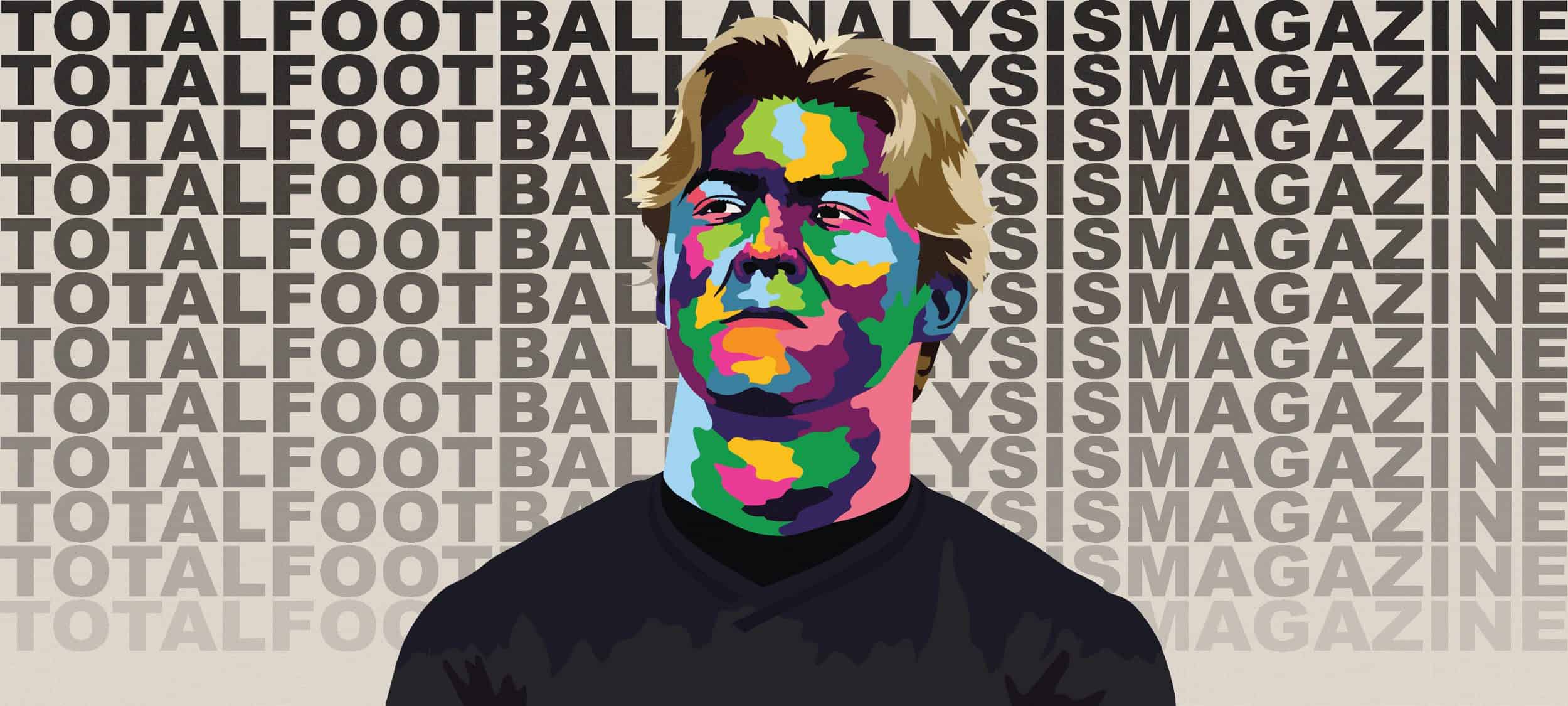




Comments